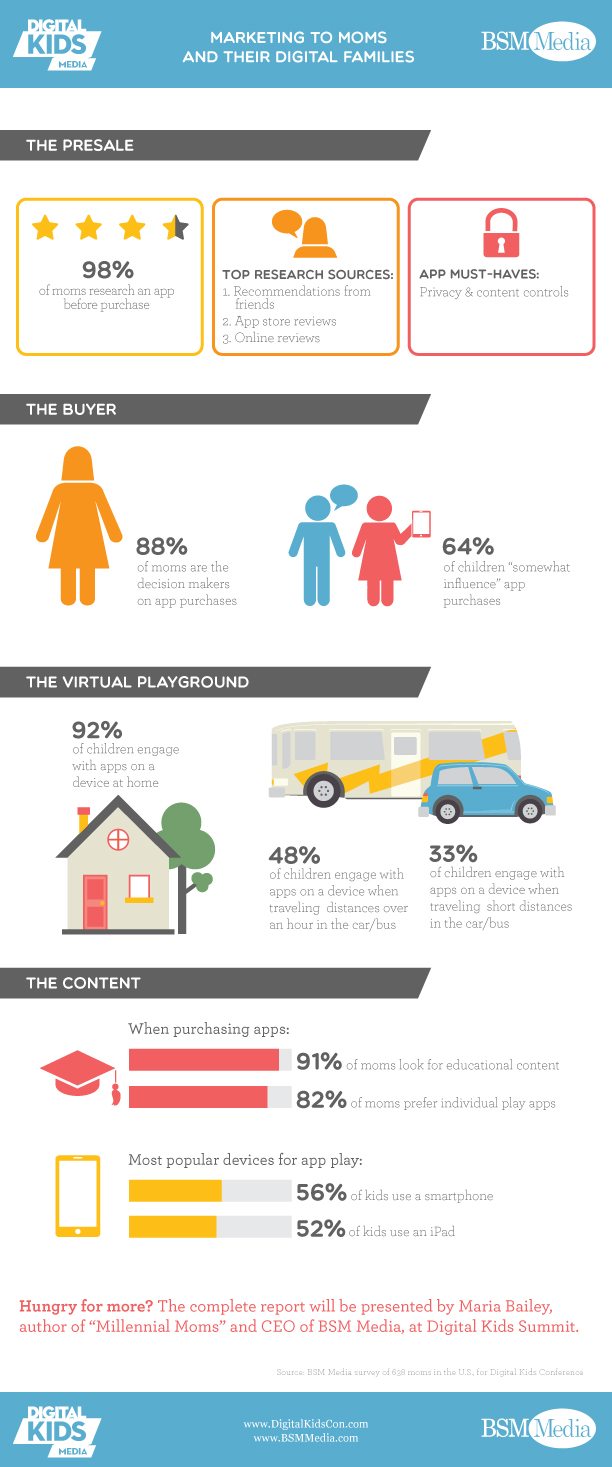Category Archive for "Marketing To Moms"

Dear Doctor: How To Market To Moms
 I recently completed a four-article series on marketing to moms for Bentson Clark reSource, a quarterly publication dedicated entirely to orthodontic practices. Why orthodontists, you may ask? This particular healthcare category is all about moms and their children, of course. For the back story, I have Chris Bentson to thank for the opportunity to contribute to his newsletters and reach this audience. Chris asked me to keynote at a conference way back in 2011, and we have worked together many times since then. It goes to show the power of moms across every category, and that Chris is smart for recognizing and promoting the connection in what is an annual $11 billion orthodontics niche.
I recently completed a four-article series on marketing to moms for Bentson Clark reSource, a quarterly publication dedicated entirely to orthodontic practices. Why orthodontists, you may ask? This particular healthcare category is all about moms and their children, of course. For the back story, I have Chris Bentson to thank for the opportunity to contribute to his newsletters and reach this audience. Chris asked me to keynote at a conference way back in 2011, and we have worked together many times since then. It goes to show the power of moms across every category, and that Chris is smart for recognizing and promoting the connection in what is an annual $11 billion orthodontics niche.
Here are a few tips to consider for marketing to moms that work for orthodontists, health care practitioners and any business or brand that works with moms. These tips are from my latest book, “Millennial Moms: 202 Facts Marketers Need to Know to Build Brands and Drive Sales” (Wyatt-MacKenzie, 2015):
- Upgrade Appointment Options: Moms don’t want to talk on the phone. Only 19% of GenX mothers want to speak with a customer service agent (i.e., scheduling rep or office manager). Explore options for online appointment software and appointment reminders via text or email. Make it easy for moms to calendar appointment days and times on their phones. While live phone conversations are not going away, especially in healthcare offices, moms will appreciate any time they gain back by avoiding long telephone calls.
- Social Media Presence: Today’s moms (and their tweens and teens) will look for social media presence if only as a reflection of a progressive practice. If you and your staff can manage a social media account or two, start with Facebook and Instagram and start practicing social listening. Moms appreciate relevant, informative content, and they really love to be “liked” and followed on social media. Respond to comments when appropriate. Including this kind of engagement in your social strategy is imperative. On the flip side, if regular posting, maintenance and social listening is not an option, wait until resources are available to start and maintain a healthy and social media presence.
- Social Listening and Audits: Every company and brand with a social media presence should be practicing social listening and conducting regular social media audits. Listen to what moms are saying. Search relevant keywords, hashtags, company and brand names to see what moms are talking about and respond when appropriate. Search your practice name and hashtags related to the industry on a regular basis to determine see what moms are talking about, then comment when appropriate. Perform an online audit by checking online search sites to check for accuracy of company contact information. Speaking from recent experience, nothing is more frustrating to busy moms than searching for a phone number or information that is incorrect.
- Powerful Word of Mom: Finally, regardless of the many social media tactics that I consider a must for practices, good old-fashioned word of mouth, or “word of Mom” is invaluable in gaining new patients. Moms love to socialize and share their latest finds on the playground, in the carpool line and anywhere they gather with friends and family. Consider outreach at community events, sponsoring school activities and underwriting school sports teams (apparel, equipment, etc.) as just of the few ways to show moms that you are involved in the community.
As I wrote earlier, the power of moms in the marketplace is widespread. In writing this article about a specific niche, I can’t think of one consumer category where moms are not relevant. To continue the conversation, tweet me @momtalkradio.

5 Ways Mom Consumer Communities Help Grow Your Bottom Line

There was once a time when most of us were listening to music on cassette tapes, when brands interacted with consumers only in focus group facilities and information was gathered via phone surveys. Today, the options to engage with customers are boundless. Technology’s rapid growth birthed a new wave of advancement. Everything from our dog’s collar to our refrigerator is “smart” and while technology continues to advance, it begs the question, “Are brands any smarter in the way they are growing their bottom line?” The truth might hurt some.
When it comes to today’s mothers, the tactic for engagement with the greatest return on investment can be found in consumer communities. These groups may conjure up images of brand ambassadors or in-house research panels, however, what I am referring to is a community of moms with each one screened for influence, brand enthusiasm, social reach and interest in contributing to the growth of the brand. Its members socialize with each other as well as brand representatives in a private online community and provide more than just insights or sales support. These women are an extension of the brand. They are available for insights whether the request for input is coming from engineers, retail designers or product development teams. They earn exclusive sneak-peeks and product previews and some even receive flowers from the brand on their birthdays.
Moms in the consumer community actively support the goals of the brand by posting about new products, bringing PR opportunities to the company and most importantly defending the brand among their peers if crisis management is needed. Brands such as Chick-fil-A, HP, Disney, LeapFrog, Children’s Claritin and Medtronic have benefited from consumer communities created and managed by BSM Media.
HP, for example, has seen such overwhelmingly positive results that they currently have consumer communities to engage with Millennials, Moms and Gen Z influencers. During the 2016 holiday season, the HP Sprocket Photo Printer sold out after tweens and moms in their communities contributed ideas and feedback on the handheld photo printer and then promoted it to friends and peers when it launched.
Here are five ways a consumer community can boost your bottom line:
- Increase speed to market: A consumer community allows engineers and product developers to obtain quick user input and reduce the time and money loss in generation two modifications. HP was able to cut 6-8 months of development time off of two recent products- HP Sprocket Photo Printer and HP Social Media Snapshots. Moms in their HP Smart Mom Panel provided design input to engineers and eliminated the need for timely focus groups and revisions.
- Expand innovation to include consumer product ideation: Let’s face it, no one knows more about a product than the end user and having access to an entire pool of end users can produce ideas at a lower cost to the development process.
- Amplify product marketing: With a committed team of brand enthusiasts who feel vested in your product’s success, your marketing dollars stretch a whole lot further. Chick-fil-A uses their Chick-fil-A Mom’s Panel of 1,000 influencers for input on their Kid’s Meal prizes each year. The benefit is not only do they learn what moms and their children want but when the prizes appear in the Kid’s Meal a year later, the Moms feel a sense of ownership to the process and are happy to share the news with family and friends.
- Higher engagement with social media influencers: Because you screened moms for reach and influence, you eliminate the cost of re-engagement with influencers each time you need them for marketing programs. LeapFrog was paying high agency fees every time they wanted to execute a blogger outreach campaign for a new product. By creating a panel of moms who loved the LeapFrog brand, they were able to engage with these women over and over again. Posts were authentic because their relationship with the brand was long term.
- Deeper insights about your products and brands: Allowing consumers to have conversations among themselves in a safe community gives you and your team a “fly on the wall” perspective on their opinions. HP learned so much about the user experience associated with their HP Instant Ink subscription program and printers, that they inserted a customer service representative into their HP Instant Ink community and later used the process to enhance customer support on a wider level.
As brand leadership continues to look for ways to get more out of their investment, we will see an increase in brands creating consumer communities. When done right, it provides easy and direct access to insights, deeper relationships with social influencers and cost-savings to bringing innovative products to market.
BSM Media designs and manages consumer communities for brands based on your goals and objectives. All community members are screened and recruited for influence, brand enthusiasm and channels of communication with peers. For more information, please email Maria Bailey at maria@bsmmedia.com or call BSM Media at 954-943-2322, ext.1. Additional information can be found at www.bsmmedia.com.

Four Marketing to Moms Tactics for 2017
 There’s been a lot of debate around the death of the mom blogger. Regardless of what side of the fence you fall on in the argument, the good news is that mom bloggers have given birth to social media influencers with greater reach and more channels to deliver your message. Yesterday’s mom blogger has extended her reach to Instagram where she showcases her favorite brands. She’s also come out from behind her laptop in order to share her opinions with peers on Facebook Live. All of this has changed the marketing to moms landscape and how brands can use these influencers to connect with mothers. Here are four tactics important to success in 2017 and a few examples of moms who are effectively using them.
There’s been a lot of debate around the death of the mom blogger. Regardless of what side of the fence you fall on in the argument, the good news is that mom bloggers have given birth to social media influencers with greater reach and more channels to deliver your message. Yesterday’s mom blogger has extended her reach to Instagram where she showcases her favorite brands. She’s also come out from behind her laptop in order to share her opinions with peers on Facebook Live. All of this has changed the marketing to moms landscape and how brands can use these influencers to connect with mothers. Here are four tactics important to success in 2017 and a few examples of moms who are effectively using them.
Facebook Live: Before the commercials aired, moms had already discovered the fun (and effectiveness) of Facebook Live. From at-home unboxings and lifestyle segments to product reviews and in-store peeks, moms like Joey Fortman of Reality Moms have embraced Facebook Live. For her #CoffeeConvoWednesdays, Cindy Simmons of Surviving Mommy attracts thousands of viewers per video by picking three topics and weaving them in to a casual conversation.
Brands such as Chick-fil-A are finding success in connecting with moms through virtual events. BSM Media recently produced such an event for Chick-fil-A’s brand ambassadors and Cristy Clarke, the founder of Table Topics. Over 200 moms took part in the online broadcast moderated by BSM Media’s CEO, Maria Bailey. Moms were able to submit their own questions for Cristy Clarke and were posting to social media throughout the one-hour event. Chick-fil-A garnered over 1 million impressions online about their new kid’s meal toy thanks to the multiple posts generated by the moms in attendance.
To learn more about virtual events, contact Mary@bsmmedia.com.
Instagram: Moms love posting pictures of family life, and of course the craziness that is parenthood. Ilana Wiles of MommyShorts shares snippets of her NYC life, incorporating brands that resonate with her personally, for authentic content. Naomi Davis of LoveTaza boasts almost ½ million followers by sharing colorful life stories through photos. Watching these Instagrammers’ posts will give brands a good idea of what attracts their followers, particularly fellow moms.
BSM Media’s Social Spotters program is a turnkey marketing tactic that generates Instagram posts of your product on the shelf and in the retail environment. Play Monster leveraged BSM Media’s Social Spotters during a recent product launch in national toy stores and generated over 7 million online impressions.
To learn more about Social Spotters, email ElizaBeth@bsmmedia.com
Ambassador Programs: As I watch ambassador groups evolve, it’s sometimes easier to convey what is NOT a good example. Mom ambassador groups are not about paying a group of mom influencers to post a required number of times each month on your behalf. It’s not gathering up a bunch of bloggers and asking them to put a button on their blog with your logo on it. An effective ambassador group is gathering a group of moms who truly love your brand through thick and thin. They are super fans and will defend your brand in a time of crisis. They will go to bat for you no matter what because they are loyal. You probably already know a few of these customers. Find them on social media and cultivate them in a group. Give them a name and solidify the relationship with them to make it beneficial for them as well as you.
BSM Media manages Influencer Ambassador Groups for dozen of brands including HP and Chick-fil-A. To learn more about Ambassador and Advocacy Programs visit BSMMedia.com.
Influencer Insights: Researchers tend to hire what I call professional focus group participants for their survey. Behind two-way glass, they watch and wait for insights. In 2017, try doing more social listening. Watch for hashtags about your brand, specifically targeted to it or through keywords and topics related to it. Conversations between moms are rich in ideas, potential product changes and great ideas for marketing and social media campaigns.
I hope your 2017 is off to a great start and that you’ll utilize these tactics before Q1 is over! It’s going to be another fun year working with moms and brands, experiencing the lightning fast growth of social media playgrounds and the mom influencers who play in them.
To learn more on how BSM Media can help your brand connect with Moms and their families, please email Maria@Bsmmedia.com.
A Different Kind Of Shopping Experience: Marketing To The Moms Of College-Bound Children
While most mothers are focused on the holiday shopping season, there is one segment of moms who are actively doing another type of shopping — college shopping. Yes, it’s that time of year when mothers with high school seniors are eagerly awaiting SAT or ACT results, sifting through direct mail pieces from colleges and universities and loading up the car for campus tours.
As the mother of four, I have personally experienced the anxiety of college searches while consulting with numerous university admissions offices on a professional basis. Marketing to the mother of a college-bound student has its own unique tricks and tips in order to be successful in a competitive market where school year price tags per student average $10,000 for in-state tuition to $40,000 and more for private and/or out-of-state tuition.
Here are my tips for administration, staff and recruiters based on research, as well as professional and personal experience.
1. At the end of the day, moms want happy, safe and well-educated children who are employable at the end. Don’t forget to highlight the safety element in your long list of “Top College” accolades. There’s nothing worse than having your child fall in love with a campus only to learn through an online search that crime rates are higher than normal.
2. Don’t underestimate the importance of your student tour guides. Like any front line employee, the first people your prospective customers meet are the most important points of contact for your brand. This could not be truer than with teenagers who tend to size up their peers in the first three minutes of interaction. I’ve been on tours where the student ambassador did nothing but talk about last Friday night’s party (not a good selling point for mom) or how homesick she is because there’s no social life on campus (not a good selling point for teenagers). No matter how much you are spending on glossy marketing materials that fill the mailbox weekly or how slick your customized portal is for the prospective student, if the campus tour is a bust, the student will quickly lose interest, and so will mom.
3. Keep the Mom in the loop. Yes, it’s time to let go, but most college-bound students aren’t paying for college alone. Mothers want to know where their money is going, particularly if it’s $40,000 – $50,000 of it. Offer the option for duplicate emails (one to the student, one to mom), or better yet, customize emails with financial, safety and success rate information that will go a long way toward winning over the family to your institution.
4. Invite the family to immerse themselves into a different experience. There is no shortage of colleges inviting moms, dads and students to visit their campuses. To get the attention of your prospective students, do something unique, different and customized. Last month, a college sent my daughter (a drama student) complimentary tickets to the fall performance of “Grease.” A few years ago, a school recognized my son’s interest in engineering by inviting him to a science exhibit on campus. Athletic departments do it all the time. They recruit prospective players to stand on the sidelines before a big game to truly deliver the feeling of being part of the team. There are lessons to be learned by this practice.
5. Enlist the help of subject department chairmen, professors or students to engage with recruits with similar interests. My daughter received a personalized email from the head of the theater department of a school she was not considering. She was so excited and impressed with his apparent interest that she not only applied but also fell in love with the college after a campus tour. As a marketer, I didn’t have the heart to tell her that it was likely an email campaign but I did congratulate the admissions department on their successful marketing tactic.
Technology as well the increased number of college-bound students has changed the way higher-level education institutions market to families. There’s a need and demand for customized admission portals and email updates. However, when it comes to the personal decision of selecting a college, there’s no replacement for the value of personal interactions.
Moms Dish Up Thoughts On Black Friday And Cyber Monday
As we approach Thanksgiving week, I’m gearing up for my annual Black Friday shopping excursion. Yes, I admit it. I am one of those Black Friday shoppers, out the door before sunrise with holiday gift list in hand to shop for my family, friends and team. I knock out the rest of the list on Cyber Monday. I’m calling myself a hybrid shopper, and you’ll read why below.
With the enormous growth of Cyber Monday, expected to be the largest online shopping day in history at $91.6 billion this year, per Forbes.com, I was curious how moms are shopping this year. I launched an unofficial poll on my Facebook page and found interesting and clear preferences for moms, whom we know are the primary shoppers in the household, especially at the holidays.
Are moms moving away from Black Friday shopping and staying home to shop in their pajamas? Is Black Friday the preferred day to shop, and why? How do moms feel about retailers opening on Thanksgiving night? The comments to my unofficial poll reveal the expected strong opinion, which I’ve narrowed down to shoppers in three categories: the traditional, frugal and hybrid.
Traditions Rule
- Traditions for moms are no surprise. Moms focus on family time on Thanksgiving Day and over the long weekend. These moms, and most in the Facebook poll, showed a strong preference for Cyber Monday shopping, where they don’t have to battle crowds and chaos in stores and get the same or better deals online. Jenn Greene of Maryland sums it up, “LOVE Cyber Monday because shopping in PJ’s is perfection.”
- When it comes to early store openings on Thanksgiving Day, tradition rules again in favor of family time. Many moms posted comments against retailers that open on Thanksgiving night, even posting links to Facebook groups like “Boycott Black Friday”. New York mom Ellen Gerstein said, “I really resent retailers who open at all on Thanksgiving. Call me old fashioned, but I don’t see the need.”
- Another tradition to mention is the moms who make Black Friday shopping an annual bonding ritual with family and friends. Dawn, a mom of two from New Jersey, commented, “It has become a tradition to go shopping on Black Friday with my sister-in-law, but it’s more for fun girl time.”
Frugal Moms Save The Day
- By the time Black Friday rolls around, price-conscious or frugal moms have already checked and compared prices online, finished most of their shopping and will only venture to stores if the sale prices are worth the trip. Free shipping is expected. These moms are shopping like ElizaBeth Wilson, mom of twins from Florida, “I check the deals online on Friday-Monday. I won’t step foot in a store, but if there are actual good sales online, and not just free shipping offers, I’ll be making some purchases!”
- Frugal moms aren’t waiting for Black Friday or Cyber Monday. They are shopping seasonal sales throughout the year, snapping up deals online and in stores before Black Friday, when sales prices are there anyway.
Hybrid Moms Shopping All The Time
- Whether it’s a tradition, good sales or both, hybrid moms are flexible and willing to shop on both Black Friday and Cyber Monday. About 60% of moms echoed the comments of Texas mom-of-two Erica Pena-Vest, “I do both (Friday & Monday) but refuse to shop on Thanksgiving just out of principle.”
The anecdotal evidence from my Facebook poll supports more shopping on Cyber Monday for busy moms, ringing true for the Forbes.com estimates of a record-breaking online sales day on Nov. 28.
Finally, there was one comment that I had to include, in what may be the true motivation for early shopping on Thanksgiving. Lily Ashley, a mom of six children from Long Island posted, “I will be shopping on both days, and I do appreciate the businesses that open on Thanksgiving because not everyone wants to sit with in-laws all day.”
Happy Thanksgiving to you and yours!
What’s New For Holiday 2016
It’s that time again when brands are looking for the silver bullet that will drive holiday sales and help them meet their goals for 2016. Unfortunately, many marketing teams set their plans in place back in the spring. I say unfortunately because in a time when social media is constantly changing, it’s nearly impossible to predict what social platform will be popular six months in advance.
Ask anyone last February if they would be talking about Facebook Live for live-streaming videos and I will bet they would have told you to put your money on Periscope. The platforms that moms are using move as fast as a toddler in a ball pit. Marketing to moms has become a fluid environment and those who are not flexible in their marketing plans miss the full potential of the market. So what are some of the most effective new marketing tactics for the 2016 season?
- Facebook Live: There’s a reason I mention this platform first. I choose Facebook Live over a single blog post for most product reviews. A picture (in this case video) is worth a thousand words and a Facebook Live video can attract thousands of viewers to your product.
- YouTube videos: Millennials shop with the advice of videos. YouTube is their search engine of choice and it’s where they look when researching a product and for product comparisons (features and price). There are very affordable YouTubers who are willing to review product and now is the perfect time to add this to marketing tests.
- Amazon Video Reviews: I’ve never been a fan of inauthentic product reviews and neither are consumers. This is perhaps why Amazon recently clamped down on brands paying bloggers to post reviews on product pages. There are several approved video providers for Amazon who will review your product and post video reviews on your product page and social media.
- Instagram: it’s not new but its influence has grown since last year, particularly with young consumers (i.e., millennial moms). It’s a must for products and brands, and, of course, the video options make Instagram even more effective. Perhaps even more effective than blog posts.
Regardless of the social media platform du jour, the overriding lesson I have learned and always convey to clients is flexibility. Be willing to allocate or shift resources on the fly to leverage last-minute opportunities, to test programs on emerging platforms, or to capitalize on a program or campaign that’s showing excellent results. For many brands, the holiday season can represent 30% or more of annual sales, a number that makes holiday marketing and social media campaigns so important.
Are you using the social media platforms listed above? I’d love to hear your experiences here or tweet me at @momtalkradio to continue the conversation.
Let’s Celebrate National College Move-In Week! #AtHomeStores
It’s the halfway point in the Great College Move-In Road Trip for At Home stores to mark National College Move-In Week! From Chicago on Sunday through Charlotte and on through Orange Park and Orlando this weekend, we’re celebrating National College Move-In Week as over 130 colleges and universities welcome students back to campus this week. Follow my road trip journey (on Facebook and Twitter) as I meet moms in different cities who will showcase the 50,000 items in At Home stores that make college shopping so easy on your time and budget!
Between this week and Labor Day, an estimated 20 million students will be moving in to college dorms and apartments across the U.S. College Move-In season is a unique, exciting and often-bittersweet milestone for families as students venture out of the nest to live on their own for the first time. Mixed with the excitement of moving to college are the costs and time to furnish a new living space. In a recent survey of moms by BSM Media for At Home, we discovered shopping priorities of moms and students, dorm room must-haves and the high costs of the college move-in season.
- Tablets, TVs, string lights and wall hangings top the packing lists for college-bound students. When students are packing their tech items and new décor, they don’t forget a childhood memento or two like a stuffed bear or blanket.
- Moms are purchasing mattress covers, under bed storage bins and other essentials, making sure their sons and daughters have everything they need for college living.
- 46% of moms say the college checklist will cost between $400 and $600.
- Another 37% of moms estimate moving costs (fuel, time off of work, packing supplies) at more than $500.
- For décor ideas and inspiration, 66% of moms are checking online retail sites, followed closely by Pinterest as a preferred source of inspiration for 62% of moms.
- Over 45% of moms say they will furnish and decorate the dorm room with fresh, new items, 43% will combine a mix a fairly even mix of new purchases and items from home, and only 9% are furnishing the spaces only with items brought from home.
Moms in the survey feel the most stress making sure their sons and daughters have everything they will need (61%), followed by their college student leaving home for the first time (43%) and getting them moved in (37%).
From firsthand experience after moving two of my children to collegiate housing over the last few weeks, I know how exciting and exhausting the college move-in process can be for parents. At Home makes it easy to make a one-stop trip to get the décor items the students want, the basics that moms know are necessary for a new living space, and all at very reasonable pricing. Find an At Home store near you at http://athome.com.
The Story Behind The Numbers On Moms And Millennials
ecently, The New York Times turned its attention to women without children and marketing to this group. If you missed the article on July 10, you can read it here. I was fortunate enough to be a part of Alina Tugend’s article that referenced the lucrative mom market. Tugend worked on this piece for over a month and gathered extensive data on women, both childless and with children. It reminded me of how often we read statistics, census data and research and react to the numbers without knowing the story behind them.
“Childless Women to Marketers: We Buy Things, Too” noted that nearly half of all women between 15 and 44 do not have children. There’s no debating the numbers; however, there is a reason for the increase in childless numbers today. Allow me to peel back the layers for you. Millennials are now the largest generation in our country at approximately 80 million. However, only one-third of all millennial women have had children. Multiple resources, including our own research done in conjunction with the release of Millennial Moms: 202 Facts Marketers Need to Know to Build Brands and Drive Sales illustrate that Millennial women are delaying motherhood.
What all this means is that there is a huge wave of new moms coming in the next three to five years; at least half of those women ages 15 to 35 will become moms in the future. This means that marketers need to be preparing today for the opportunities of tomorrow. As technology changes, it will be necessary for marketers to change their tactics to gain the results they desire.
I’m not going to take on the debate as to whether brands should add childless women to their menu of target consumers. I will leave that to CMOs and brand managers.
The 2016 presidential campaign has been a good source of data surrounding millennials. The media has lumped all millennial voters together, characterizing their behaviors as one giant, homogenized cohort. Just last night, I heard a political talking head declare that 80% of millennials get their news from Twitter, which means that more political messages have to be delivered via Twitter. Any seasoned marketer can tell that same commentator that there is a distinct difference between older millennials (30+) and younger millennials (18+).
I agree that you are likely to find older millennials combing for news on Twitter; however, Snapchat is where younger millennials dwell. Millennials shouldn’t be lumped together in a pool of data because it doesn’t tell the whole story. The same can be said for women with or without children.
5 Reasons To Engage With Moms In Online Community Research Groups
A 2015 market research industry paper reports a 52% increase in online communities, a tool that smart marketers will leverage when engaging with moms. Traditional research tools that my team uses every day, such as focus groups and surveys, have value and will continue to play a role in keeping a finger on the pulse of opinions and trends. However, the increase in online communities resonates with the hottest consumer segment today — millennial moms.
Millennial moms spend an average of four hours on their phones each day (rarely using it to talk) and 81% form an opinion of a brand based on social media presence. Their constant use and reliance on social media means that brands that implement and cultivate an active online community are gaining valuable resources for research and information while cultivating loyal relationships with their very influential mom consumers.
It’s a win-win for moms and brands for these five reasons:
1. Cost/Savings: Compared to traditional research tools, online communities are a cost effective way to reach consumers. In the days before online groups, research through focus groups, for instance, was either limited to local/regional groups or required extensive travel costs and time. Online communities save time and money.
2. Immediate Feedback: In this digital age of instant access to information, this fact is a marketer’s dream. Product research and development can be cut in half and consumer insights and opinions are a quick post away.
3. 24/7 Engagement: Moms check their phones anytime and anywhere, from the dinner table or during a midnight feeding. Most millennial moms aren’t constrained by the idea of brands posting during “business hours.” Online hours offer flexibility for both parties; brands post any time and moms can respond any time.
4. Long-term Relationships With Your Best Advocates: Marketers who tap in to the moms who are already talking about their brand on Facebook, Twitter or Instagram (to name a few) are capitalizing on their love of communication and engagement with a brand. Online groups build brand loyalty with these moms.
5. Consumer-Generated Content and Ideas: Social listening is critical for any brand, and online communities are an excellent source of information. Organic conversations that develop in a group can offer important feedback, positive and negative. Conversations can also evolve in to an idea that comes from, in my opinion, the best source of solutions: moms.
In my recent experience, the best example of online mom communities comes from ambassador groups. These groups hit on all five points above, validating moms’ expectations of the brand, while the brand leverages relationships with moms to gauge opinions on new products, test package designs, rebranding strategies and much more.



Recent Comments